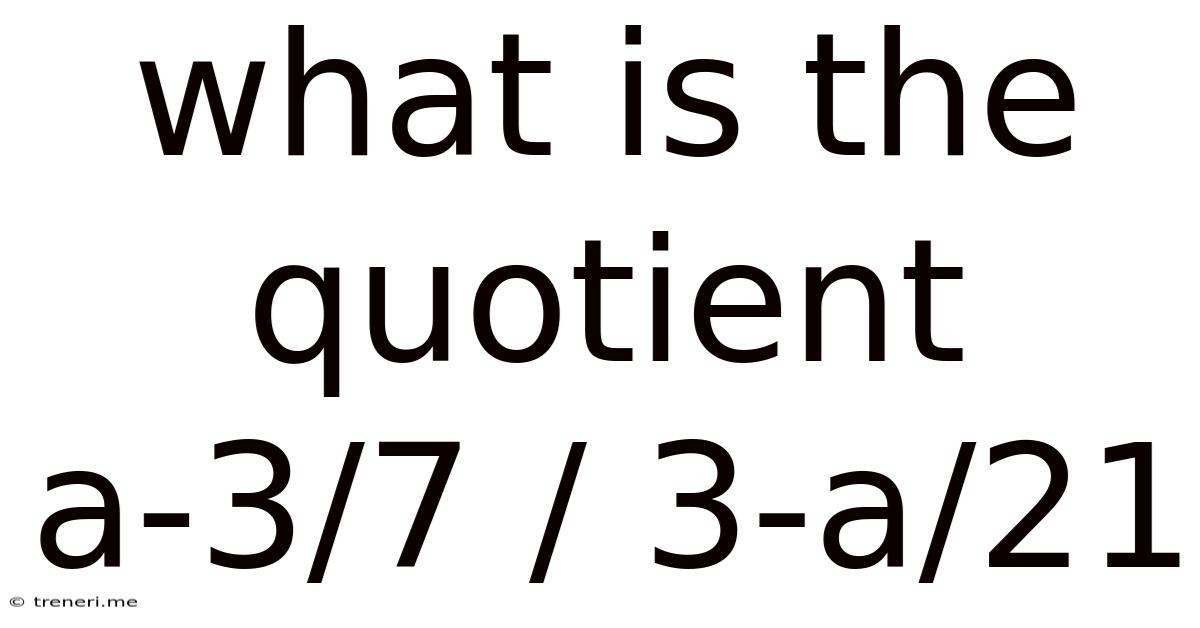What Is The Quotient A-3/7 / 3-a/21
Treneri
May 09, 2025 · 4 min read

Table of Contents
What is the Quotient (a-3)/7 / (3-a)/21? Simplifying Algebraic Fractions
This article will delve into the simplification of the algebraic fraction ((a-3)/7) / ((3-a)/21). We'll break down the process step-by-step, explaining the underlying principles of algebraic manipulation and fraction division. Understanding this type of problem is crucial for mastering algebra and building a strong foundation for more advanced mathematical concepts. We will also explore related concepts and potential pitfalls to avoid.
Understanding the Problem: A Deep Dive into Fraction Division
The expression ((a-3)/7) / ((3-a)/21) represents a division of two fractions. Remember that dividing by a fraction is the same as multiplying by its reciprocal. This is a fundamental concept in arithmetic and algebra.
Key Concepts to Remember:
- Reciprocal: The reciprocal of a fraction is obtained by flipping the numerator and the denominator. For example, the reciprocal of a/b is b/a.
- Sign Changes: Notice that the numerator (a-3) and the denominator (3-a) have opposite signs. Understanding how to manipulate these signs is crucial for simplifying the expression.
- Factoring: Factoring algebraic expressions is a powerful technique that simplifies complex expressions.
Step-by-Step Solution: Simplifying the Algebraic Fraction
Let's break down the simplification process into manageable steps:
Step 1: Rewrite the Division as Multiplication
The first step in simplifying the given expression is to convert the division operation into multiplication. We do this by multiplying the first fraction by the reciprocal of the second fraction.
((a-3)/7) / ((3-a)/21) becomes ((a-3)/7) * (21/(3-a))
Step 2: Identify and Utilize Opposing Signs
Notice that (a-3) and (3-a) are opposites. We can rewrite (3-a) as -(a-3). This substitution is key to simplifying the expression.
Substituting, we get: ((a-3)/7) * (21/-(a-3))
Step 3: Simplify the Expression
Now, we can cancel out the common factor (a-3) from both the numerator and the denominator.
This leaves us with: (1/7) * (21/-1)
Step 4: Perform the Multiplication
Finally, multiply the remaining fractions:
(1/7) * (21/-1) = 21/(-7)
Step 5: Final Simplification
Simplify the resulting fraction:
21/(-7) = -3
Therefore, the simplified form of ((a-3)/7) / ((3-a)/21) is -3. This holds true for all values of 'a' except for a=3, as this would lead to division by zero, which is undefined.
Exploring Related Concepts and Potential Pitfalls
This problem highlights several crucial concepts in algebra, including:
- Fraction Division: A clear understanding of how to divide fractions is essential. This involves multiplying by the reciprocal.
- Working with Negative Numbers: Correctly handling negative signs is critical, especially when dealing with expressions involving subtraction.
- Factoring: Identifying and factoring common terms simplifies complex expressions.
- Avoiding Division by Zero: It's crucial to always check for values of the variable that would result in division by zero. In this case, 'a' cannot equal 3.
Common Mistakes to Avoid:
- Incorrectly Handling Negatives: Students often make errors when dealing with negative signs, especially when factoring. Pay close attention to the signs when simplifying expressions.
- Forgetting to Find the Reciprocal: Remember that dividing by a fraction is equivalent to multiplying by its reciprocal. Failing to take the reciprocal is a common mistake.
- Ignoring Restrictions on Variables: Always check for values of the variables that would lead to division by zero.
Practical Applications and Further Exploration
The ability to simplify algebraic fractions like this has many practical applications in various fields:
- Physics: Simplifying equations in physics often involves manipulating fractions and algebraic expressions.
- Engineering: Engineers use algebraic manipulation to solve problems related to circuits, mechanics, and other areas.
- Computer Science: Simplifying algebraic expressions is crucial in algorithm design and optimization.
- Finance: Algebraic manipulations are used in financial modeling and calculations.
Expanding on the Concept: More Complex Examples
While the example we worked through was relatively straightforward, the same principles apply to more complex expressions. For instance, consider the following:
((2a² - 6a) / (a² - 9)) / ((4a) / (a + 3))
To solve this, you would follow similar steps:
- Rewrite as Multiplication: Multiply the first fraction by the reciprocal of the second.
- Factor: Factor the numerator and denominator of both fractions. This will reveal common terms that can be canceled.
- Simplify: Cancel out common factors and perform the remaining multiplication.
Solving such problems builds your proficiency in algebraic manipulation and reinforces your understanding of fractions.
Conclusion: Mastering Algebraic Fraction Simplification
Mastering the simplification of algebraic fractions is a cornerstone of algebraic proficiency. Understanding the principles of fraction division, factoring, and handling negative numbers is essential. By carefully following the steps and understanding the underlying concepts, you can confidently tackle even more complex algebraic fraction problems. Remember to always check for potential errors, especially regarding negative signs and division by zero. Practice is key to mastering this skill and building a strong foundation in algebra. The more you work through these types of problems, the more comfortable and proficient you will become.
Latest Posts
Latest Posts
-
Greatest Common Factor Of 24 And 84
May 09, 2025
-
0 9 Rounded To The Nearest Tenth
May 09, 2025
-
How Much Is 24 Fluid Ounces
May 09, 2025
-
How Many Days Is 460 Hours
May 09, 2025
-
How Many Ounces In 32 Cups
May 09, 2025
Related Post
Thank you for visiting our website which covers about What Is The Quotient A-3/7 / 3-a/21 . We hope the information provided has been useful to you. Feel free to contact us if you have any questions or need further assistance. See you next time and don't miss to bookmark.